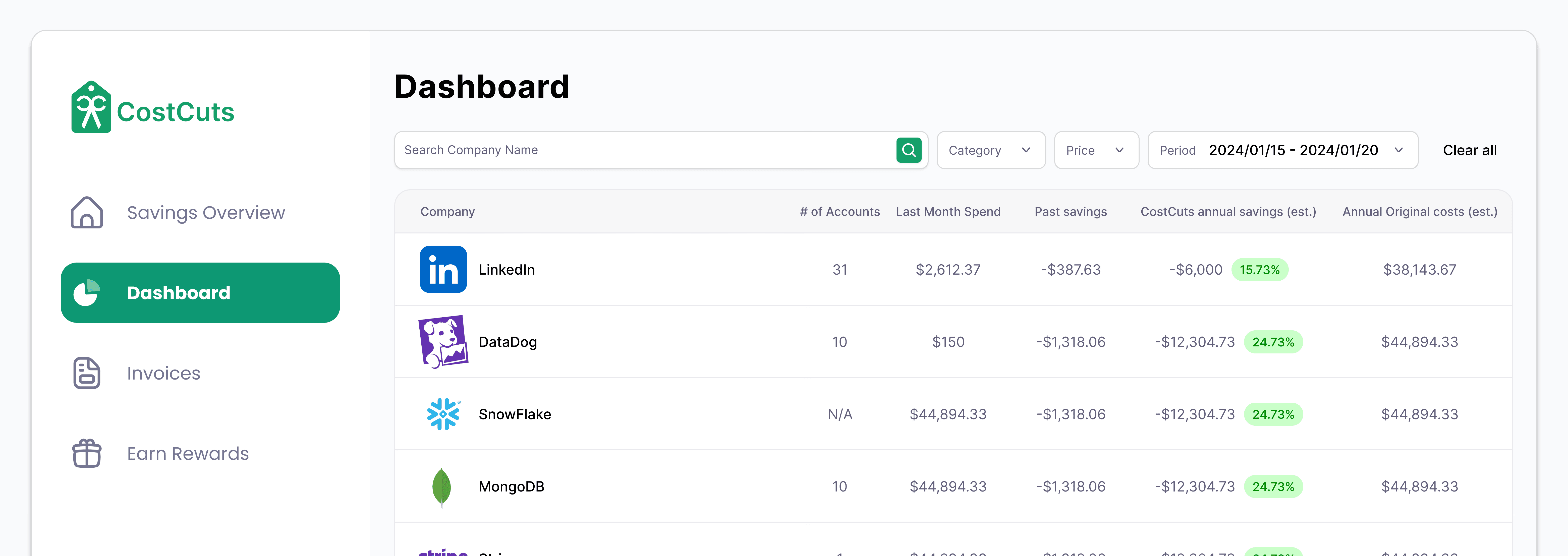Tips and tricks
Tips and tricks
How GPOs Can Lower Your Software Spend
How GPOs Can Lower Your Software Spend
How GPOs Can Lower Your Software Spend
Discover how Group Purchasing Organizations (GPOs) unlock massive savings for SaaS. Learn their benefits, challenges, and real-world success stories, including how you can benefit.
Discover how Group Purchasing Organizations (GPOs) unlock massive savings for SaaS. Learn their benefits, challenges, and real-world success stories, including how you can benefit.
Discover how Group Purchasing Organizations (GPOs) unlock massive savings for SaaS. Learn their benefits, challenges, and real-world success stories, including how you can benefit.



Imagine saving tens of thousands of dollars annually on your software expenses while accessing premium support and better contract terms—all without lifting a finger. This is the power of Group Purchasing Organizations (GPOs), which have long been game-changers in industries like healthcare and retail. Today, SaaS-focused GPOs like CostCuts are opening new doors for businesses looking to optimize software spend.
Most businesses waste 30% or more on underutilized or overpriced software (Flexera). With CostCuts, companies can reclaim this wasted spend while keeping full control of their tools. In this guide, we’ll explore the benefits of GPOs, their challenges, and actionable steps to leveraging them effectively, all backed by in-depth case studies.
1. What is a Group Purchasing Organization (GPO)?
A GPO pools the purchasing power of its members to secure better prices, terms, and services from vendors. By combining demand, these organizations unlock discounts and benefits typically reserved for enterprise clients.
How Traditional GPOs Work
Members join a GPO to align their purchasing needs.
The GPO negotiates bulk deals with vendors, leveraging the combined volume of its members.
Members enjoy discounted pricing and additional perks (e.g., faster delivery and enhanced support).
SaaS-Specific GPOs: A New Frontier
Traditional GPOs focus on physical goods like medical supplies or office furniture. However, SaaS GPOs like CostCuts specialize in software procurement, offering savings on tools like payroll systems, project management platforms, and HR software. This shift addresses a growing pain point for businesses: skyrocketing SaaS costs.
2. Benefits of GPOs
1. Cost Savings
GPOs unlock significant volume discounts, saving businesses up to 30% on procurement costs.
Example: Healthcare GPOs save U.S. hospitals over $34 billion annually, according to the Healthcare Supply Chain Association (HSCA).
2. Enhanced Supplier Relationships
Vendors prioritize GPO clients because of predictable, high-volume demand. This often translates into priority service, faster issue resolution, and additional perks.
3. Time Efficiency
With the GPO handling negotiations, contracts, and vendor relationships, businesses save valuable time.
4. Expert Market Insights
Many GPOs provide consulting and data analytics to help members make smarter decisions about procurement.
5. Rapid Access to Savings
CostCuts ensures its software deals are readily available for clients, adapting to procurement timelines to provide immediate value.
3. Challenges of Group Purchasing
While GPOs offer undeniable benefits, they also come with potential hurdles:
1. Loss of Autonomy
Traditional GPOs often require members to adopt specific vendors or products, limiting flexibility. A business might have to switch to a supplier if it doesn’t want to adjust.
2. Diverse Needs
Members in different industries or of different sizes may have conflicting procurement priorities. A retailer’s software needs differ greatly from a law firm’s for example.
3. Unequal Benefits
Larger members often drive the group’s volume, receiving the lion’s share of the savings.
4. Limited Innovation
Traditional GPOs rarely operate in dynamic sectors like SaaS, where tools and pricing evolve rapidly.
4. Real-World Success Stories: Going Deeper
Case Study: Vizient’s Healthcare Success
Background: Vizient is the largest GPO in the healthcare sector, representing over 4,000 hospitals.
Challenge: Hospitals face massive procurement costs, from medical devices to pharmaceuticals. Individual negotiations often result in inflated pricing due to lack of scale.
Solution: Vizient aggregates demand across its network, negotiating enterprise-level deals with suppliers. It also offers consulting services to ensure members maximize their savings.
Results: In 2021, Vizient saved members over $15 billion, with individual hospitals reducing supply costs by 10–15% while gaining access to priority shipping and exclusive vendor agreements.
Case Study: Texas Retail Coalition
Background: Fifteen small retailers in Texas faced increasing competition from large chains and needed to reduce costs on essential tools like POS systems.
Challenge: As independent businesses, they couldn’t qualify for volume-based discounts from major vendors.
Solution: By forming a local GPO, the retailers pooled their demand and negotiated collectively with Square.
Results: Each retailer saved an average of $3,500 annually, gained early access to new POS features, and simplified contract management.
5. How CostCuts Overcomes GPO Challenges
CostCuts has reimagined the GPO model to address common challenges:
1. Full Autonomy
Unlike traditional GPOs, CostCuts doesn’t force members to adopt specific tools or vendors. Businesses retain complete control over their software choices.
2. Alignment of Needs
CostCuts focuses exclusively on commonly used SaaS platforms like Slack, Gusto, and Rippling, ensuring aligned priorities among members.
3. Transparent Savings
CostCuts uses a transparent pricing model, ensuring that businesses of all sizes benefit proportionally from the discounts.
4. SaaS-Focused Innovation
As a SaaS-specific GPO, CostCuts adapts to the fast-changing software landscape, continuously negotiating new deals and offering tools to analyze software usage.
5. Rapid Access to Procurement Savings
CostCuts adapts to clients’ procurement timelines, ensuring software deals are ready when businesses need them, avoiding delays.
6. Practical Steps to Leverage GPOs
Audit Your Procurement Needs
Identify which software tools you’re overpaying for or underutilizing.
Research GPO Options
Look for GPOs that align with your industry or specific procurement categories.
Join a SaaS-Specific GPO
CostCuts specializes in SaaS, offering pre-negotiated savings on top software tools.
Engage Key Stakeholders
Involve leadership and department heads to ensure company-wide alignment.
Conclusion: Why CostCuts is the SaaS GPO of Choice
CostCuts isn’t just a GPO; it’s a partner in optimizing your software spend. By addressing traditional GPO challenges and focusing exclusively on SaaS, CostCuts delivers unmatched savings, time efficiency, and flexibility.
Ready to cut costs without compromise? Join CostCuts today and save up to 20% on the software your business already uses.
Imagine saving tens of thousands of dollars annually on your software expenses while accessing premium support and better contract terms—all without lifting a finger. This is the power of Group Purchasing Organizations (GPOs), which have long been game-changers in industries like healthcare and retail. Today, SaaS-focused GPOs like CostCuts are opening new doors for businesses looking to optimize software spend.
Most businesses waste 30% or more on underutilized or overpriced software (Flexera). With CostCuts, companies can reclaim this wasted spend while keeping full control of their tools. In this guide, we’ll explore the benefits of GPOs, their challenges, and actionable steps to leveraging them effectively, all backed by in-depth case studies.
1. What is a Group Purchasing Organization (GPO)?
A GPO pools the purchasing power of its members to secure better prices, terms, and services from vendors. By combining demand, these organizations unlock discounts and benefits typically reserved for enterprise clients.
How Traditional GPOs Work
Members join a GPO to align their purchasing needs.
The GPO negotiates bulk deals with vendors, leveraging the combined volume of its members.
Members enjoy discounted pricing and additional perks (e.g., faster delivery and enhanced support).
SaaS-Specific GPOs: A New Frontier
Traditional GPOs focus on physical goods like medical supplies or office furniture. However, SaaS GPOs like CostCuts specialize in software procurement, offering savings on tools like payroll systems, project management platforms, and HR software. This shift addresses a growing pain point for businesses: skyrocketing SaaS costs.
2. Benefits of GPOs
1. Cost Savings
GPOs unlock significant volume discounts, saving businesses up to 30% on procurement costs.
Example: Healthcare GPOs save U.S. hospitals over $34 billion annually, according to the Healthcare Supply Chain Association (HSCA).
2. Enhanced Supplier Relationships
Vendors prioritize GPO clients because of predictable, high-volume demand. This often translates into priority service, faster issue resolution, and additional perks.
3. Time Efficiency
With the GPO handling negotiations, contracts, and vendor relationships, businesses save valuable time.
4. Expert Market Insights
Many GPOs provide consulting and data analytics to help members make smarter decisions about procurement.
5. Rapid Access to Savings
CostCuts ensures its software deals are readily available for clients, adapting to procurement timelines to provide immediate value.
3. Challenges of Group Purchasing
While GPOs offer undeniable benefits, they also come with potential hurdles:
1. Loss of Autonomy
Traditional GPOs often require members to adopt specific vendors or products, limiting flexibility. A business might have to switch to a supplier if it doesn’t want to adjust.
2. Diverse Needs
Members in different industries or of different sizes may have conflicting procurement priorities. A retailer’s software needs differ greatly from a law firm’s for example.
3. Unequal Benefits
Larger members often drive the group’s volume, receiving the lion’s share of the savings.
4. Limited Innovation
Traditional GPOs rarely operate in dynamic sectors like SaaS, where tools and pricing evolve rapidly.
4. Real-World Success Stories: Going Deeper
Case Study: Vizient’s Healthcare Success
Background: Vizient is the largest GPO in the healthcare sector, representing over 4,000 hospitals.
Challenge: Hospitals face massive procurement costs, from medical devices to pharmaceuticals. Individual negotiations often result in inflated pricing due to lack of scale.
Solution: Vizient aggregates demand across its network, negotiating enterprise-level deals with suppliers. It also offers consulting services to ensure members maximize their savings.
Results: In 2021, Vizient saved members over $15 billion, with individual hospitals reducing supply costs by 10–15% while gaining access to priority shipping and exclusive vendor agreements.
Case Study: Texas Retail Coalition
Background: Fifteen small retailers in Texas faced increasing competition from large chains and needed to reduce costs on essential tools like POS systems.
Challenge: As independent businesses, they couldn’t qualify for volume-based discounts from major vendors.
Solution: By forming a local GPO, the retailers pooled their demand and negotiated collectively with Square.
Results: Each retailer saved an average of $3,500 annually, gained early access to new POS features, and simplified contract management.
5. How CostCuts Overcomes GPO Challenges
CostCuts has reimagined the GPO model to address common challenges:
1. Full Autonomy
Unlike traditional GPOs, CostCuts doesn’t force members to adopt specific tools or vendors. Businesses retain complete control over their software choices.
2. Alignment of Needs
CostCuts focuses exclusively on commonly used SaaS platforms like Slack, Gusto, and Rippling, ensuring aligned priorities among members.
3. Transparent Savings
CostCuts uses a transparent pricing model, ensuring that businesses of all sizes benefit proportionally from the discounts.
4. SaaS-Focused Innovation
As a SaaS-specific GPO, CostCuts adapts to the fast-changing software landscape, continuously negotiating new deals and offering tools to analyze software usage.
5. Rapid Access to Procurement Savings
CostCuts adapts to clients’ procurement timelines, ensuring software deals are ready when businesses need them, avoiding delays.
6. Practical Steps to Leverage GPOs
Audit Your Procurement Needs
Identify which software tools you’re overpaying for or underutilizing.
Research GPO Options
Look for GPOs that align with your industry or specific procurement categories.
Join a SaaS-Specific GPO
CostCuts specializes in SaaS, offering pre-negotiated savings on top software tools.
Engage Key Stakeholders
Involve leadership and department heads to ensure company-wide alignment.
Conclusion: Why CostCuts is the SaaS GPO of Choice
CostCuts isn’t just a GPO; it’s a partner in optimizing your software spend. By addressing traditional GPO challenges and focusing exclusively on SaaS, CostCuts delivers unmatched savings, time efficiency, and flexibility.
Ready to cut costs without compromise? Join CostCuts today and save up to 20% on the software your business already uses.
Imagine saving tens of thousands of dollars annually on your software expenses while accessing premium support and better contract terms—all without lifting a finger. This is the power of Group Purchasing Organizations (GPOs), which have long been game-changers in industries like healthcare and retail. Today, SaaS-focused GPOs like CostCuts are opening new doors for businesses looking to optimize software spend.
Most businesses waste 30% or more on underutilized or overpriced software (Flexera). With CostCuts, companies can reclaim this wasted spend while keeping full control of their tools. In this guide, we’ll explore the benefits of GPOs, their challenges, and actionable steps to leveraging them effectively, all backed by in-depth case studies.
1. What is a Group Purchasing Organization (GPO)?
A GPO pools the purchasing power of its members to secure better prices, terms, and services from vendors. By combining demand, these organizations unlock discounts and benefits typically reserved for enterprise clients.
How Traditional GPOs Work
Members join a GPO to align their purchasing needs.
The GPO negotiates bulk deals with vendors, leveraging the combined volume of its members.
Members enjoy discounted pricing and additional perks (e.g., faster delivery and enhanced support).
SaaS-Specific GPOs: A New Frontier
Traditional GPOs focus on physical goods like medical supplies or office furniture. However, SaaS GPOs like CostCuts specialize in software procurement, offering savings on tools like payroll systems, project management platforms, and HR software. This shift addresses a growing pain point for businesses: skyrocketing SaaS costs.
2. Benefits of GPOs
1. Cost Savings
GPOs unlock significant volume discounts, saving businesses up to 30% on procurement costs.
Example: Healthcare GPOs save U.S. hospitals over $34 billion annually, according to the Healthcare Supply Chain Association (HSCA).
2. Enhanced Supplier Relationships
Vendors prioritize GPO clients because of predictable, high-volume demand. This often translates into priority service, faster issue resolution, and additional perks.
3. Time Efficiency
With the GPO handling negotiations, contracts, and vendor relationships, businesses save valuable time.
4. Expert Market Insights
Many GPOs provide consulting and data analytics to help members make smarter decisions about procurement.
5. Rapid Access to Savings
CostCuts ensures its software deals are readily available for clients, adapting to procurement timelines to provide immediate value.
3. Challenges of Group Purchasing
While GPOs offer undeniable benefits, they also come with potential hurdles:
1. Loss of Autonomy
Traditional GPOs often require members to adopt specific vendors or products, limiting flexibility. A business might have to switch to a supplier if it doesn’t want to adjust.
2. Diverse Needs
Members in different industries or of different sizes may have conflicting procurement priorities. A retailer’s software needs differ greatly from a law firm’s for example.
3. Unequal Benefits
Larger members often drive the group’s volume, receiving the lion’s share of the savings.
4. Limited Innovation
Traditional GPOs rarely operate in dynamic sectors like SaaS, where tools and pricing evolve rapidly.
4. Real-World Success Stories: Going Deeper
Case Study: Vizient’s Healthcare Success
Background: Vizient is the largest GPO in the healthcare sector, representing over 4,000 hospitals.
Challenge: Hospitals face massive procurement costs, from medical devices to pharmaceuticals. Individual negotiations often result in inflated pricing due to lack of scale.
Solution: Vizient aggregates demand across its network, negotiating enterprise-level deals with suppliers. It also offers consulting services to ensure members maximize their savings.
Results: In 2021, Vizient saved members over $15 billion, with individual hospitals reducing supply costs by 10–15% while gaining access to priority shipping and exclusive vendor agreements.
Case Study: Texas Retail Coalition
Background: Fifteen small retailers in Texas faced increasing competition from large chains and needed to reduce costs on essential tools like POS systems.
Challenge: As independent businesses, they couldn’t qualify for volume-based discounts from major vendors.
Solution: By forming a local GPO, the retailers pooled their demand and negotiated collectively with Square.
Results: Each retailer saved an average of $3,500 annually, gained early access to new POS features, and simplified contract management.
5. How CostCuts Overcomes GPO Challenges
CostCuts has reimagined the GPO model to address common challenges:
1. Full Autonomy
Unlike traditional GPOs, CostCuts doesn’t force members to adopt specific tools or vendors. Businesses retain complete control over their software choices.
2. Alignment of Needs
CostCuts focuses exclusively on commonly used SaaS platforms like Slack, Gusto, and Rippling, ensuring aligned priorities among members.
3. Transparent Savings
CostCuts uses a transparent pricing model, ensuring that businesses of all sizes benefit proportionally from the discounts.
4. SaaS-Focused Innovation
As a SaaS-specific GPO, CostCuts adapts to the fast-changing software landscape, continuously negotiating new deals and offering tools to analyze software usage.
5. Rapid Access to Procurement Savings
CostCuts adapts to clients’ procurement timelines, ensuring software deals are ready when businesses need them, avoiding delays.
6. Practical Steps to Leverage GPOs
Audit Your Procurement Needs
Identify which software tools you’re overpaying for or underutilizing.
Research GPO Options
Look for GPOs that align with your industry or specific procurement categories.
Join a SaaS-Specific GPO
CostCuts specializes in SaaS, offering pre-negotiated savings on top software tools.
Engage Key Stakeholders
Involve leadership and department heads to ensure company-wide alignment.
Conclusion: Why CostCuts is the SaaS GPO of Choice
CostCuts isn’t just a GPO; it’s a partner in optimizing your software spend. By addressing traditional GPO challenges and focusing exclusively on SaaS, CostCuts delivers unmatched savings, time efficiency, and flexibility.
Ready to cut costs without compromise? Join CostCuts today and save up to 20% on the software your business already uses.




